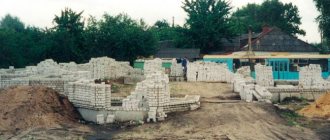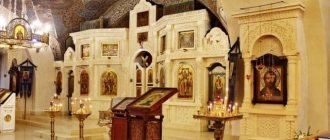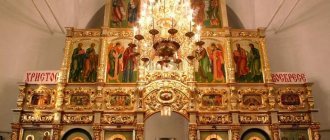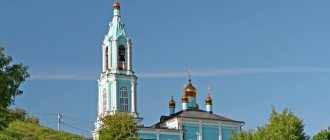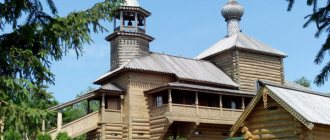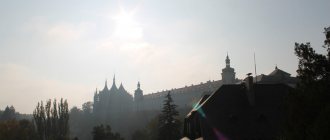Mir
Russia Republic of Tatarstan Bolgar St. Abraham's Church (Bolgar) Map is loading...
{"format":"leaflet","minzoom":false,"maxzoom":false,"limit":50,"offset":0,"link":"all","sort":[""], "order":[],"headers":"show","mainlabel":"","intro":"","outro":"","searchlabel":"\u2026 \u0441\u043b\u0435\ u0434\u0443\u044e\u0449\u0438\u0435 \u0440\u0435\u0437\u0443\u043b\u044c\u0442\u0430\u0442\u044b","default":"","import-annotation":false,"width ":"auto","height":"350px","centre":{"text":"","title":"""link":"""lat":54.96559500000000042518877307884395122528076171875,"lon": 49.05171599999999898500391282141208648681640625,"icon":""},"title":"","label":"","icon":"","lines":[],"polygons":[], "circles":[ ],"rectangles":[],"copycoords":false,"static":false,"zoom":8,"defzoom":14,"layers":["OpenStreetMap"],"image layers":[] ,"overlays":[],"resizable":false,"fullscreen":true,"scrollwheelzoom":true,"cluster":false,"clustermaxzoom":9,"clusterzoomonclick":true,"clustermaxradius":80, "clusterspiderfy":true,"geojson":"","clicktarget":"","showtitle":true,"hidenamespace":false,"template":"","userparam":"","activeicon": "","pagelabel":false,"ajaxcoordproperty":"","ajaxquery":"","locations":[{"text":"\u003Cb\u003E\u003Ca href=\"/palomnik/%D0% A1%D0%B2%D1%8F%D1%82%D0%BE-%D0%90%D0%B2%D1%80%D0%B0%D0%B0%D0%BC%D0%B8%D0%B5 %D0%B2%D1%81%D0%BA%D0%B0%D1%8F_%D1%86%D0%B5%D1%80%D0%BA%D0%BE%D0%B2%D1%8C_(% D0%91%D0%BE%D0%BB%D0%B3%D0%B0%D1%80)\» title=\»\u0421\u0432\u044f\u0442\u043e-\u0410\u0432\u0440\u0430\ u0430\u043c\u0438\u0435\u0432\u0441\u043a\u0430\u044f \u0446\u0435\u0440\u043a\u043e\u0432\u044c (\u0411\u043e\u043b\u0433\u0 430\u0440)\»\u003E\ u0421\u0432\u044f\u0442\u043e-\u0410\u0432\u0440\u0430\u0430\u043c\u0438\u0435\u0432\u0441\u043a\u0430\u044f \u0446\u0435\u0 440\u043a\u043e\u0432\u044c (\u0411\u043e\u043b\u0433\u0430\u0440)\u003C/a\u003E\u003C/b\u003E\u003Chr /\u003E\u003Ca href=\"/palomnik/%D0%A1%D0%B2%D0 %BE%D0%B9%D1%81%D1%82%D0%B2%D0%BE:%D0%90%D0%BD%D0%BD%D0%BE%D1%82%D0%B0%D1% 86%d0%b8%d1%8f \ "title = \" \ u0421 \ u0432 \ u043e \ u0439 \ u0441 \ u04442 \ u0432 \ u043e: \ u0410 \ u043d \ u043d \ u0432 \ u0430 \ u0430 \ u0430 \ u0430 \ u0430 \ u0430 \ u0430 \ u0430 \ u0430 \ u0430 \ u0430 \ u. 0446 \ U0438 \ U044F \u003E\u0410\u043d\u043d\u043e\u0442\u0430\u0446\u0438\u044f\u003C/a\u003E: \u0413\u043b\u0430\u0432\u043d\u044b\u0435 \u 0441\u0432\u044f\ u0442\u044b\u043d\u0438 — \u043c\u043e\u0449\u0438 \u0441\u0432\u044f\u0442\u043e\u0433\u043e \u043c\u0443\u0447\u0435\u043d\ u0438\u043a\u0430\u0410\u0432 \u0440\u0430\u0430\u043c\u0438\u044f \u0411\u043e\u043b\u0433\u0430\u0440\u0441\u043a\u043e\u0433\u043e \u0438 \u0446\u0435 \u043b\u0435\u0431\u043d\u044b \u0439 \u0438\u0441\u0442\u043e\u0447\u043d\u0438\u043a, \u0431\u044c\u044e\u0449\u0438\u0439 \u043d\u0430 \u043c\u0435\u04 41\u0442\u0435\u0433\u0438\ u0431\u0435\u043b\u0438 \u043c\u0443\u0447\u0435\u043d\u0438\u043a\u0430 \u0410\u0432\u0440\u0430\u0430\u043c\u0438\u044f \u 0411\u043e\u043b\u0433\u0430\ u0440\u0441\u043a\u043e\u0433\u043e.","title":"\u0421\u0432\u044f\u0442\u043e-\u0410\u0432\u0440\u0430\u0430\u043c\u0438\u0435\u0 432\u0441 \u043a\u0430\u044f \u0446\u0435\u0440\u043a\u043e\u0432\u044c (\u0411\u043e\u043b\u0433\u0430\u0440)»»link»:»»»lat»:54.9655950000 0000042518877307884395122528076171875," lon":49.05171599999999898500391282141208648681640625,"icon":""}],"imageLayers":[]}
54.965595; 49.051716
Russia, Republic of Tatarstan, Spassky district, Bolgar, Likhacheva street, 144
Bolgar, Republic of Tatarstan422840
Russia
St. Abraham's Church (Bolgar)
- Orthodox church in the city of Bolgar in the Republic of Tatarstan. The main shrines are the relics of the holy martyr Abraham of Bulgaria and the healing spring that flows at the site of the death of the martyr Abraham of Bulgaria.
History[edit]
In the anniversary year of the Baptism of Rus' 1988, the temple was moved from the village of Porfirovka in the Spassky district, which is located 15 km from the city of Bolgar. The village was dying, and the wooden church (it is more than a hundred years old, it was created according to the design of the Kazan architect Malinovsky in the traditions of rural wooden architecture) had long been in a state of desolation.
The founder of the temple, Archpriest Sergius, served in Porfirovka at the end of the 19th and beginning of the 20th centuries. There was no church in the village, and services took place in a small chapel. The parish, which included the two large villages of Porfirovka and Molostvovka, numbered about two and a half thousand people. A church was needed, and the village pastor understood this. Imbued with this good thought, he accepted it as a guide to action. Living more than modestly, he saved on everything, trying to realize his dreams in practice. But the parishioners found out about this shortly before the death of the shepherd, who publicly revealed the secret of his life’s feat. And he did this because the accumulated funds were not enough to build the temple. With tears in his eyes, the priest gave all his savings to people in the hope that there would be people who could see the matter through to the end. But what could the villagers, the poor and destitute, who had just emerged from the yoke of serfdom, offer? They had no money, but they had tired, calloused hands, accustomed to working. And they decided: in the off-season, when there is no field work, they will selflessly work for the Glory of God. Soon the Lord provided a solution to the material problems: the local landowner, touched by the grief of the priest and the common people, added the missing funds and building materials. In 1895, in the village of Porfirovka, a wooden three-altar church was built in the name of the Life-Giving Trinity with warm chapels: the Nativity of Christ and the martyrs Sergius and Bacchus. Father Sergius soon died and was buried not far from the temple. In 1930, the church was closed and was used as a grain warehouse. The priest's grave was desecrated: they were looking for valuables. This was done by the “grateful” descendants of those people for whom this temple was created. Today there is nothing left of the village; the Porfirovites are scattered around the world - they no longer have a homeland.
In 1988, residents of Bolgar (then still a district town of Kuibyshev) got the local authorities to open a temple. In the entire district at that time there was only a small prayer house in the village of Rzhavets, 10 kilometers from Bolgar. (Currently in the Spassky district there are 9 operating parishes for 17 thousand baptized. The density of churches per capita in the Spassky district is the highest in Russia). Permission was obtained with difficulty. At first, services were held in a prayer house, and then believers were allocated an area at the entrance to the city, near the Orthodox cemetery. With the blessing of Archbishop Anastasius of Kazan and Tatarstan, the Church of the Holy Trinity from the village of Porfirovka was transported to the city of Bolgar. The temple was revived solely with donations from ordinary Orthodox people. Some parts of the temple have fallen into disrepair over the years, and the demands of time have changed the original appearance of the building. In today's version, the single-altar church has a multi-domed ending and is dedicated, with the blessing of the ruling bishop, to the martyr Abraham, the Bulgarian wonderworker.
On the day of remembrance of the Prophet Elijah, August 2, 1989, the first Liturgy took place in the church. In 1990, July 28, on the day of remembrance of the Holy Equal-to-the-Apostles Prince Vladimir, the ruling bishop, Bishop of Kazan and Mari Anastasius, performed the full rite of consecration of the temple.
With the beginning of the nineties and the collapse of the country, the economy, and the general decline in living standards, construction was very difficult. However, during this time a lot has been done: the iconostasis was built, the ceiling of the temple and the altar were painted, a shrine was built for the relics of the martyr Abraham, water supply was installed, bell tower extensions were erected, the territory of the temple was paved. A refectory, a prosphora room, and a utility block (boiler room, storage rooms) were built.
Not seeing the human possibility of continuing construction, it was decided to intensify church-wide prayer. Every Friday, after the Liturgy, serve an akathist to the heavenly patron - the martyr Abraham, asking him to show help from above. Through the prayers of God's saint, something happened that no one could even imagine: the miraculous self-renewal of the icons began, a gracious fragrance and the flow of myrrh from them.
In 2008, the walls of the two-story right side aisle of the church were erected to accommodate the baptism and Sunday school. In the same year, the construction of the first house for monastics was completed, a monument to the martyr Abraham was erected, and a cattle yard was built.
At the site of the suffering of the martyr Abraham, a general reconstruction was carried out: the well was cleared, a chapel and fence were built, and the territory was landscaped.
Trip to Bolgar
On a cold November day, a friend who called me longingly remembers a pilgrimage to the ancient Volga town of Bolgar, imagining it as some mysterious fairy-tale land: “There, in the summer, swallows build nests in the church, they fall silent during the Liturgy, then they begin to chirp again, and in the winter, butterflies fly around the church. She also told about the relics of the holy martyr Abraham, which believers from many regions of Russia come to venerate, and about the holy spring of the Bulgarian wonderworker, which heals the sick with grace. Svetlana herself went for spiritual advice to Father Vladimir Golovin, the rector of St. Abraham's Church, a preacher of a rare gift, so convincingly and simply conveying the truths of the Gospel that after a conversation with him more than once people came to understand the lives they had lived and human destinies changed. Before the frost hits, I have to go, I decide. And why wait? There are still two seasons until the warmth, let this be the last trip of the outgoing year. “Let’s go,” I persuade my husband Alexander, who reluctantly evaluates the route. 400 kilometers is a long way. At my request, my friend Yulia reads out information from the Internet over the phone: “A unique historical ensemble - the city has preserved ancient Bulgar buildings of the 13th century, there are mosques and minarets, the Orthodox Church of the Dormition of the Blessed Virgin Mary of the 18th century, as well as a museum in which the heritage of the times is presented on display Golden Horde". “There’s a lot to see,” she concludes. Inspired, without frivolously asking for blessings, we ourselves made the road difficult and full of temptations, but, apparently, God was pleased to lead us to this wonderful city. We decided to leave Samara at five in the morning - you can get to Father Vladimir for a conversation only by making an appointment before lunch. Having stopped at a gas station first, we were convinced that the path to Bolgar would be thorny. “Fill in twenty liters,” the husband said to the gas station attendant. Not a drop entered the tank. “The sensor in the car is faulty,” the seller snapped. As it turned out later, everything was in order, but the saleswoman refused to explain anything. “We’ll wait until the gas station management wakes up—we’ll be late,” the husband decides. - Let's go to another one. My mood is spoiled, but with the onset of dawn I take up the akathist to the Mother of God “Deliverer from Troubles” - after all, we are going through Tashla. Seeing familiar poppies, I ask the Lady to help me on the way. Dimitrovgrad remains behind, then Cherdakly and ice on the highway. The car that cut us off on summer tires brakes sharply and starts speeding. The brakes don’t obey, and we fly into the ravine from a three-meter height. The trunks of pine trees flash before my eyes. This is the end - flashes through my head. Luckily, we fell on dead wood without feeling the impact. The husband inspects the car - it is undamaged. I look at him reproachfully - our tires were “bald”. Having gotten used to dry asphalt in the city, I didn’t change the tires to winter ones, hoping for a Russian “maybe.” And the culprit of our fall has long disappeared. Having unscrewed the battery, my husband goes to help another driver who, at the same time as us, flew into a ditch from the oncoming lane. Returning, he cuts down the snags with an ax, clearing the way up. With offense, the thought comes: how can this be, after all, we were traveling with prayer? But surprisingly soon, as if answering my silent question, help arrives - a tow truck from Ulyanovsk. Looking around the ravine, the driver, for some reason not entirely sober, says with indifference: “They could have broken their necks.” He reads out the price list for services and lazily secures the cable. Having pulled out the car with grief, we move on, trying to penetrate each other’s thoughts: who will be the first to say: “we’re turning back”? But we keep going. We'll probably be late for Father's, because it's already lunchtime. You'll have to ask. There was only hope for the only reason - we had a good reason, we fell into a ravine. The dull autumn landscape of deserted plains and woodlands is not at all pleasing to the eye and for some reason makes us remember the fall of the first people. Instead of emerald fields there are weeds and dead wood, “thorns and thistles” growing on barren land. I put the road map aside - the long-awaited sign is finally visible: Bolgar. At the edge of the coniferous forest there is a graveyard, and next to it there is an old wooden church. Maybe we should go here? We enter the gate and see the icon of St. Abraham greeting pilgrims. You can't go wrong anymore. With what difficulty we got there!
In the temple of his relics. More precisely, the phalanx of the saint’s finger, left over from the relics lost during the godless years of hard times. The life of the martyr tells that this rich and noble merchant lived at the end of the 12th - beginning of the 13th century in Volga Bulgaria, was an unusually compassionate person, merciful to the needy and spent his wealth on the needs of the suffering. While visiting Russian cities, he became deeply interested in the Christian faith. According to God's vision, grace touched his heart, and, having learned the truth of the holy faith of Christ, he accepted Holy Baptism, after which the saint began to carry the apostolic preaching among his people with the Gospel word, and most importantly, with the Christian way of life. The image of the saint is also imprinted on a wooden symbolic shrine, to which those who come here venerate with love and gratitude. The iconography of the St. Abraham's Church, even in the twilight, is bright and piercing, contrasting with the dilapidated, unpainted boards on the outside of the church, which combine the joyful color of painting and the archaic nature of wooden architecture. It was difficult to surprise us, “experienced” pilgrims, with the decoration of the temple, but here we felt some special splendor and truly unearthly beauty. But, perhaps, this was not what struck me most, but the feeling that time had stopped here, the bustle was left somewhere far behind, giving way to reflection and spiritual activity. “Holy Father Abraham, pray to God for us,” I ask. Signed up and made it in time. You can go to the source. We are looking for a way, driving around a small town. Private houses and cozy courtyards flash by. The birch grove rustles with fallen leaves. The sunset puts orange spots on the tree trunks. Behind the grove is a pine forest and a sandy road leading to the Volga. On the border of the forest and the river there is a holy spring. Here, according to legend, Saint Abraham of Bulgaria suffered martyrdom. The Bulgars became irritated with the preacher of Christianity and began to beat him “with the whole world,” leaving not a single undamaged place on his body. For many days the Bulgars tortured him in prison, forcing him to renounce the Christian faith. Seeing his inflexibility, the fanatics took him outside the city and, not far from the bank of the Volga, first cut off his hands, then his legs, and then his head. Having revealed a miracle, a spring of healing water gushed out of the ground, and signs began to occur at the tomb. Soon the Lord punished the murderers - a terrible fire destroyed their capital, the Great Bulgars, to the ground. Behind the stone fence there is an ancient well. We throw the bucket, but the splash is not immediately heard. Deep. We collect cold life-giving water. The reeds sway in the ice-covered creek, and a little further on the waves of the Zhiguli Sea splash. Pilgrims come here in reverent silence, tremblingly step onto the ground consecrated by the blood of the martyr, asking for the intercession and help of the saint, remembering the high feat of the one who brought grace to this place. On this day, the Sacrament of Wedding was to take place in the Holy Abraham Church. A lot of people had gathered, everyone was waiting for Father Vladimir’s parting words addressed to the young people. Already quite frozen, we warmed up in the warm church and listened to the soulful speech of the priest. The words echo loudly: “A wedding is like fire.” Enter the Sacrament with precious metal - be purified, tempered, like gold and silver. And if you enter like old straw, you will burn without a trace. The iconostasis sparkles with gold, reflecting the light, against which there are two touching silhouettes. Holding hands, they listen to, perhaps, the most important words in their lives, transforming the understanding of their usual existence into an awareness of the high purpose of man - to be an individual, a Christian, who gives himself without reserve for the good of another. After the wedding there is a sermon that lasts two hours. Explaining the causes of troubles and disorder, the priest cites a person’s desire for everyday happiness as an example. “Happiness now or happiness always?” - he asks a question, talking about eternal life and the vanity of worldly pleasures. Lacewing butterflies fly around the temple. These are found in the south. We listen, but a nagging thought gnaws at our souls: snow has piled up during the day, and the roads have turned into a skating rink. How can we get home on summer tires? Having waited in line, in the morning, we go to talk to the priest. We ask disturbing questions, share our secrets. I'm talking about a morning misadventure on the road. “It’s okay,” Father Vladimir reassures, “many people get here with obstacles, but the way back is like clockwork.” Having received the blessing, we go back to Samara. Careless drivers who flew off the road, like us in the morning, are swarming in the road ditches. There was a major accident in Tsarevshchina: a gazelle lost control and fell from a great height. An ambulance, a tow truck and a traffic policeman are blocking the road. As if with a protective hand that lifted us out of the ravine, saved from trouble, we remember with annoyance the recent murmur. I silently think about how merciful the Lord is to man. To those who thoughtlessly visit holy monasteries, He sends admonitions, discarding ostentatious piety without true Christian virtue, and gives lessons in humility, so that living faith and trust in Him may appear. And for a long time this fertile land will be remembered, where the Divine will is so palpable, by submitting to which, we got rid of spiritual sleep and, seeing the presence of the Creator, began to correct our lives.
In the pictures: St. Abraham's Church in Bolgar;
icon of the holy martyr Abraham of Bulgaria; Archpriest Vladimir Golovin during the Divine Liturgy. Irina Temryazanskaya, Samara 12/04/2009
Current state[edit]
The temple area has been developed and landscaped from scratch: a church building with a Sunday school, a large refectory (with a capacity of up to 200 people), a small refectory (with a capacity of up to 70 people), permanent utility buildings, monastic cells, a bathhouse, and a barnyard. The territory is fenced, gasified, electricity, telephone and Internet are provided. A large-scale reconstruction of the holy well, the place of suffering of the martyr Abraham of Bulgaria, has been completed. There is a parish library. The first prayer room in the Republic was opened in the Central District Hospital. A prayer room has been opened in a boarding house for the elderly and disabled.
Orthodox churches and monasteries
Dear brothers and sisters. In the near future (with the establishment of warm weather), our parish, with God's help, hopes to continue construction work. Over the past season, the following was done: the roof on the temple (covered for now with roofing felt) and the drum above the vault. In addition, work has been carried out to renovate the prayer house, where all services and Sunday school classes have been held since the establishment of the parish in 1998. This is the old part of what was once a residential building, which also requires support, repairs, and, consequently, material investments. With the help of the parishioners, the building was replaced with old wooden windows that had fallen into disrepair with new plastic ones, rotten floors were replaced, and new linoleum was laid.
But still, the main concern of the parish is our church under construction. In the upcoming construction season, the following work is planned: erection of scaffolding, installation of a dome and cross, a tent over the bell tower. I would also like to say something about the spiritual life of our parish. Divine services in the temple are held on Sundays and holidays, the psalter is read every day. On Sundays, a prayer service with an akathist is served to the holy martyr Abraham of Bulgaria. The parishioners treat our small house of worship with love and care, decorating it as best they can. Thus, through their efforts (using donations), the icons “Faith, Hope, Love and their mother Sophia” and “Quick to Hear” were painted.
And recently the icon “The Tsaritsa” was transferred to the temple. The history of this image is unusual. A woman suffering from cancer came to church for confession before her upcoming operation. At the end of the liturgy, she ordered a prayer service “To the All-Tsarina.” This is what Father Sergius, the rector of the parish, said: “We were going to serve a prayer service to the “All-Tsarina,” but there was no icon of her in the church. I don’t know why (I don’t usually give such blessings), I turned to the woman: “I wish you could paint the icon of the “Tsarina of All” for our church.” She was even happy, she said, there was an icon painter she knew, they prayed and went their separate ways. After some time, this woman comes to the temple, joyful and happy, with the icon “The Tsaritsa” and says: “Father, they painted the icon as they blessed. During this time a miracle happened, I was completely healed. The doctors are surprised that no surgery was required.” That’s how this icon appeared in our church.” Recently, through the efforts of one of the parishioners, a beautiful carved icon case was made for this image. At the end of Lent, a prayer service will be regularly served in front of the icon with the reading of an akathist.
Activities of the parish[edit]
The parish holds about four hundred (i.e., daily activities occur) various spiritual and moral events and actions per year in government organizations:
– city central and children's libraries;
– “Chaika” children's shelter;
– Central District Hospital;
– a boarding home for the elderly and disabled;
– district military commissariat;
- department of the Ministry of Internal Affairs.
There is also cooperation with military-patriotic and public organizations.
Services for children[edit]
An annual feature are services for children: on the last Sunday of August for blessings for the new school year, Christmas liturgy (January 8) and Easter liturgy for children, after which festive concerts, poetry and song competitions, quizzes and gift distribution take place. There are up to four hundred children, more than half of whom receive communion (with the number of baptized people in the city being 7 thousand). Before the start of the school year, children are given school kits with the symbols of the temple. Children from neighboring parishes come in an organized manner.
